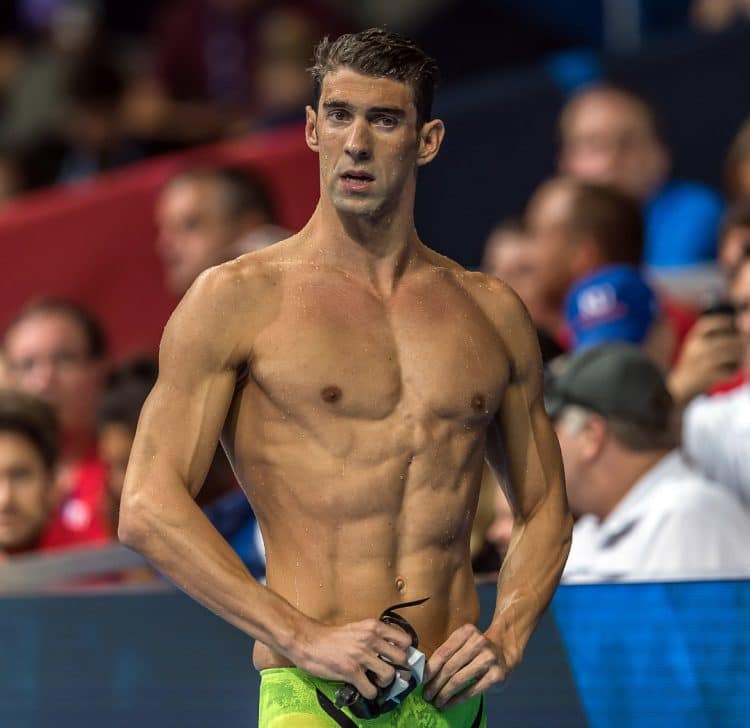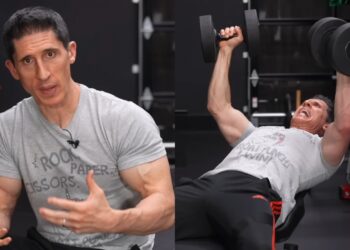Michael Phelps stunned the fans with his physical abilities when he burst onto the Olympic stage in 2004 and gobbled up half a dozen gold and two bronze medals.
While Phelps is, without a doubt, a genetic freak with a body naturally suited to the pool, his success is the result of a lifetime of hard work.
Countless hours in the pool and the gym prepared Phelps to become the winningest athlete in Olympic history — 28 total medals. In this article, we break down Michael Phelps’ training and diet.
Michael Phelps Stats
| Full Name: Michael Fred Phelps II | ||
| Weight | Height | Age |
| 194 pounds (88 kilograms) | 6’4″ | 40 years |
| Date of Birth | Birthplace | Zodiac Sign |
| June 30, 1985 | USA | Cancer |
The Michael Phelps Story
Michael Fred Phelps II was born on June 30th, 1985 in Baltimore, Maryland. He is the youngest of the three children of middle school principal Debbie Phelps and retired Maryland State Trooper, Micheal Fred Phelps. In high school and college, Michael played football and tried out for the Washington Redskins.

In 1994, when he was nine years old, Phelps’ parents divorced. He later revealed that the divorce was extremely traumatic for him and his siblings. He had begun swimming two years earlier.
“The only reason I ever got in the water was my mom wanted me to just learn how to swim. My sisters and myself fell in love with the sport, and we decided to swim.”
Get Fitter, FasterLevel Up Your Fitness: Join our 💪 strong community in Fitness Volt Newsletter. Get daily inspiration, expert-backed workouts, nutrition tips, the latest in strength sports, and the support you need to reach your goals. Subscribe for free!
Phelps was diagnosed with ADD in the sixth grade. At age 10, he achieved a national record in the 100-meter butterfly for his age group. He then began to train at the North Baltimore Aquatic Club under coach Bob Bowman.
Phelps has stated that Bowman was like a drill sergeant, insisting on discipline and regimentation. Yet, he credits his training under Bowman as being pivotal to his future success.
“Training with Bob is the smartest thing I’ve ever done … I’m not going to swim for anyone else.”
Phelps was selected for the 2000 US Olympic team at 15 years old, becoming the youngest male to make the US Olympic swim team since 1932. He did not win a medal at the 2000 Olympic Games but finished a respectable fifth in the 200-meter butterfly.
The following year, at the 2001 World Aquatic Championships, Phelps broke the world record in the 200-meter butterfly, becoming the youngest male ever to set a world swimming record.
Phelps won the first of his 23 Olympic gold medals at Athens in 2004 in the 400-meter individual medley, setting a world record time of 4:08:26. At that Games, he went on to win five more golds and two bronzes.
Four years later, at the 2008 Olympic Games in Beijing, he won an incredible eight gold medals, breaking Mark Spitz’s record of seven golds, set at the 1972 Games in Munich. After Phelps broke his record, Spitz commented —
“Epic. It goes to show you that not only is this guy the greatest swimmer of all time and the greatest Olympian of all time, he’s maybe the greatest athlete of all time. He’s the greatest racer who ever walked the planet.”
At the 2012 Summer Olympics in London, Phelps added to his gold medal tally, winning another four golds, along with two silvers. After the Games he announced his retirement, telling the world —
“I’m done. I’m finished. I’m retired. I’m done. No more,” later adding “I just wanted to be done with swimming and didn’t want anything to do with the sport anymore.”
But he wasn’t done. He came out of retirement in May 2014 to win the 100-meter butterfly event at the Arena Grand Prix in Charlotte, North Carolina. He was reported to have said that his motivation for the comeback was the recent poor performance of the US men’s swim team. By now, Phelps’ relationship with coach Bob Bowman had deteriorated. Bowman did not buy into the comeback, leading Phelps to tell him that —
“[He] wasn’t training for history. He wasn’t training for the medals. He wasn’t even training for all the fans. This time Phelps wanted to swim for himself…and enjoy the journey.
At the 2016 Olympic Games in Rio de Janeiro, Phelps continued to add to his medal collection. He won five more golds and another silver. All of this was achieved at 31 years of age, well beyond the prime for a world-class swimmer.
Phelps finally retired after the Rio Olympics. Along with his 23 gold medals, he had collected 20 Guinness world records and established himself as the greatest swimmer of all time.
Check Out: Calories Burned Swimming Calculator
Michael Phelps Nutrition Program
Michael Phelps’ nutrition program for the 2008 Olympics, where he hauled in eight golds, hit the headlines when it was revealed that he was consuming 10,000 calories per day. That may seem unbelievable, but the guy was doing a massive amount of training (six hours each day) and so needed all of those calories to fuel his way through it all.
At the time. Phelps commented —
“Eat, sleep and swim, that’s all I can do.”
Even while he was competing, Phelps would maintain his ridiculously high-calorie level. This ensured that he was never glycogen-depleted and that he was always getting the carbs he needed to perform at peak level.
Let’s break down how the Baltimore Bullet ate his way to claiming more golds at an Olympics than anyone in history.
View this post on InstagramGet Fitter, FasterLevel Up Your Fitness: Join our 💪 strong community in Fitness Volt Newsletter. Get daily inspiration, expert-backed workouts, nutrition tips, the latest in strength sports, and the support you need to reach your goals. Subscribe for free!
Breakfast
- 3 fried egg sandwiches with cheese, tomatoes, lettuce, fried onions, and mayo
- 3 choc chip pancakes
- 4 egg omelets
- 3 sugar-coated slices of French toast
- Bowl of grits
- 2 cups of coffee
Lunch
- Half a kilogram of pasta
- 2 large ham and cheese sandwiches on white bread smothered with mayo
- Up & Go energy drink
Dinner
- Half a kilogram of pasta with carbonara sauce
- 1 large pizza
- Up & Go energy drink
While it was reported that Phelps would go up to 12,000 calories per day, he personally nixed that rumor when he wrote the following in his autobiography No Limits —
“It’s just not true. Maybe eight to ten thousand calories per day.”
He also said that he never cooks, adding the following in a 2010 NBC TV interview —
“I was told that I was supposed to eat between eight and 10,000 calories a day. I just sort of try to cram whatever I can into my body. It’s pretty much whatever I feel like eating, I’m going to eat.”
Of course, most people who followed the type of diet outlined above would end up getting fat. Yet, Phelps maintained an average body fat level of just eight percent, thanks to all of that time spent in the pool and the gym.
Michael Phelps Supplement Regime
Michael Phelps used three key supplements to help fuel his body during his competitive career:
- Creatine — Creatine helps replenish your ATP levels and delays fatigue. He would take five grams of creatine monohydrate with water a half hour before training.
- Protein Shakes — Whey protein isolate with a 50/50 blend of high dextrose carbs was part of Phelps’ post-workout nutrition program to replenish amino acid and glycogen levels.
- Vitamin C — Phelps took a 1000 mg vitamin C capsule daily to fortify his immune system, keeping him free from colds, flu, and other illnesses.
Michael Phelps Workout Principles
During his swimming career, Phelps would swim at least 80,000 meters every week. To achieve that target he would be in the pool twice a day, for a total of about five hours in the water daily. He is known for listening to music with his waterproof headphones while in the pool.
Phelps swims 13 kilometers every day. He also spends about an hour in the gym three days per week, focusing on functional fitness training.
Michael Phelps Swim Workout Program
This is the swim routine that Phelps used prior to breaking all sorts of records at the 2008 Olympic Games.
Warm-Up
Michel Phelps’ warm-up for his mammoth workout sessions looks like a full-fledged workout in itself for most people. He split it into four sections which included —
Section 1
- Swim: 800 meters
- Kick: 600
- Pull: 400
- Drill: 200
Section 2
- Fast Twitch 25-meter strokes
- 50 meters x 6 sets
- Freestyle Warm-up
- Sidekick for 3 minutes
- Butterfly drill
- Pull buoy
Section 3
- Individual medley twice
- 20×100 in 1:15 min
- 25 m fly
Section 4
- 50 m freestyle
- 25 m fly
- 500 strokes: 50 kicks, 50 drills
The Main Workout
Section One
- 2000 timed kick stroke: with the kickboard
- 4×100 IM drill
- Pulling Set
- 10×200 in 3 minutes
- Speed Sets x 4
- 24×25 fly, three times: 1 Warm-up, 1 no breath, and 1 sprint
- Out of the pool core workouts, typically 500 sit-ups or bicycle crunches
- Static stretches
- Free swim cool down
Section Two (after a 20-minute break)
- 800 mixer on 10:30
- 4×150 kick on 2:30 (50 strokes, 50 free, 50 strokes)
- 400 pull with a buoy on 5:00 (breathe 3,5,7,9 per 100)
- 200 stroke on 3:00
- 10×50 in 45 min (2-25 kick/25 drills 2-25 free/25 stroke)
- 4×50 in 1:30
- 1×50 in 1:20
- 1×50 in 1:10
- 1×50 in 1:00
- Long swim 100-200-300 pull (lung busters)
- 400 choice kick
- 300-200-100 IM drills
- Speed & Endurance Training
- Vertical kicking, Underwater kicking, Training paddles, snorkel, kick
- Board, Sculling, Sled Push, Sled Reverse Fly
Related: Calories Burned Swimming Calculator.
Michael Phelps Gym Workout
The many hours that Micahel Phelps spent on the gym floor were absolutely crucial to his success. He worked out three times per week in his build-up to the 2008 Olympic Games.
Phelps was more interested in developing functional strength and muscular endurance than building muscle size. As a result, he kept the weight moderate and the reps relatively high.
Phelps did a lot of dumbbell training. Here is a typical upper body workout that he used to hit the deltoids —
- Standing dumbbell press: 3 sets x 10-16
- Dumbbell front raise: 3 sets x 10-16
- Dumbbell lateral shoulder raise: 3 sets x 10-16
Phelps is a fan of weighted bodyweight exercises, such as the pull-up and push-up. In each workout, he would pump out three sets to failure on weighted pull-ups, achieving between seven and 10 reps while wearing a 20-pound weighted vest. He would also do three sets of push-ups to failure, getting about 17-20 reps per set.
Phelps is well-known for his wide lats. Here is the back workout that he used to help achieve it. (super-setted with his chest routine) —
Superset #1
- Lat Pull-down: 3 sets x 12-15
- Dumbbell Bench Press: 3 sets x 12-15
Superset #2
- Seated Row: 3 sets x 12-15
- Dumbbell Fly: 3 sets x 12-15
Superset #3
- One-Arm Dumbbell Row: 3 sets x 12-15
- Cable Press: 3 sets x 12-15
Other Workout Programs You Might Like:
- Tom Brady Diet and Workout Plan For An NFL-Ready Physique
- Rob Gronkowski Diet and Workout Program
- Russell Westbrook Diet and Workout Program
Conclusion
Michael Phelps was able to combine superior genetics with a lifetime of intense training and practice to become the greatest swimmer the world has ever seen. His unique combination of super high calories, marathon pool sessions, and strategic weight training is what propelled him to the top.
You and I may not have the inherent gifts to make a world champion Olympic athlete, but we can all certainly learn from Michael Phelps’s work ethic to become the best version of ourselves.








